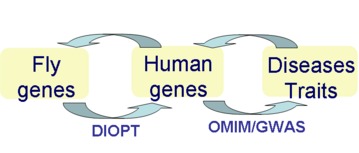URL
http://www.flyrnai.org/diopt-dist
The DIOPT-DIST Approach
Facilitating the identification of orthologs between a model organism and humans is of particular relevance to genes associated with human diseases. Keeping in mind that researchers visiting or otherwise using resources from the DRSC are often interested to identify orthologs of disease-associated genes, including genes more recently identified through genome-wide association studies (GWAS), we decided to take DIOPT results a step further by linking them up with disease associations in curated resources.
DIOPT-DIST is an online-searchable tool that maps gene-disease relationships from the NCBI Online Mendelian Inheritance in Man (OMIM) database and GWAS datasets contained in the GWAS catalog to genes in the C. elegans, Drosophila, mouse, S. cerevisiae, and zebrafish genomes using DIOPT orthologous predictions. Disease terms were extracted from OMIM and GWAS ftp files and were categorized with MeSH headings. 2 additional categories were added for the terms out of the scope of MeSH disease annotation such as disease risk factors and traits (table 4).
The user may search 1.) the related human diseases by a list of genes from model organisms; 2.) the corresponding genes in model organisms by disease term, disease category or IDs from OMIM. Both gene/locus OMIM IDs (starts with * or + on the OMIM website eg. 100650) and disease phenotype OMIM IDs (starts with # or % on the OMIM website eg. 610251) can be searched at DIOPT-DIST (table 5).
Figure 2: The DIOPT-DIST Approach

Table 4. Disease Categories
| ID | Disease Category | Source |
| C01 | Bacterial Infections and Mycoses | MeSH heading |
| C02 | Virus Diseases | MeSH heading |
| C03 | Parasitic Diseases | MeSH heading |
| C04 | Neoplasms | MeSH heading |
| C05 | Musculoskeletal Diseases | MeSH heading |
| C06 | Digestive System Diseases | MeSH heading |
| C07 | Stomatognathic Diseases | MeSH heading |
| C08 | Respiratory Tract Diseases | MeSH heading |
| C09 | Otorhinolaryngologic Diseases | MeSH heading |
| C10 | Nervous System Diseases | MeSH heading |
| C11 | Eye Diseases | MeSH heading |
| C12 | Male Urogenital Diseases | MeSH heading |
| C13 | Female Urogenital Diseases and Pregnancy Complications | MeSH heading |
| C14 | Cardiovascular Diseases | MeSH heading |
| C15 | Hemic and Lymphatic Diseases | MeSH heading |
| C16 | Congenital, Hereditary, and Neonatal Diseases and Abnormalities | MeSH heading |
| C17 | Skin and Connective Tissue Diseases | MeSH heading |
| C18 | Nutritional and Metabolic Diseases | MeSH heading |
| C19 | Endocrine System Diseases | MeSH heading |
| C20 | Immune System Diseases | MeSH heading |
| C21 | Disorders of Environmental Origin | MeSH heading |
| C23 | Pathological Conditions, Signs and Symptoms | MeSH heading |
| C24 | Occupational Diseases | MeSH heading |
| C25 | Substance-Related Disorders | MeSH heading |
| C26 | Wounds and Injuries | MeSH heading |
| F03 | Mental Disorders | MeSH heading |
| Y01 | Disease risk factor, diagnosis or treatment | Added for terms not included in MeSH |
| Y02 | Trait | Added for terms not included in MeSH |
Table 5. DIOPT-DIST result page, one example of OMIM terms
| FlyBase ID | Fly Symbol | Human GeneID | Human Symbol | DIOPT Score | OMIM ID | Disease/Trait | Source |
|---|---|---|---|---|---|---|---|
| FBgn0012036 | Aldh | 217 | ALDH2 | 8 | 100650 | {Hangover, susceptibility to}, 610251 (3) | OMIM |
| 100650 | {Sublingual nitroglycerin, susceptibility to poor response to} (3) | OMIM | |||||
| 100650 | Alcohol sensitivity, acute, 610251 (3) | OMIM | |||||
| 100650 | {Esophageal cancer, alcohol-related, susceptibility to} (3) | OMIM |
Notes on Disease/Trait column:
- 100650 is an example of an OMIM ID for gene/locus terms, starting with a "+" at the OMIM website (http://omim.org/entry/100650?search=100650&highlight=100650 ).
- 610251 is an example of an OMIM ID for disease phenotype terms, starting with a "#" at the OMIM website (http://omim.org/entry/610251?search=610251&highlight=610251 ).
Disease term: {Hangover, susceptibility to}, 610251 (3)
- 610251 is the OMIM ID for the phenotype.
- Brackets, "{ }", indicate mutations that contribute to susceptibility to multi-factorial disorders or to susceptibility to infection.
- "(3)" means the molecular basis of the disorder is known.
For more information about OMIM annotation, please go to the OMIM help page (http://omim.org/help/faq).
If you have questions, suggestions or comments on DIOPT please contact our informatics staff.
